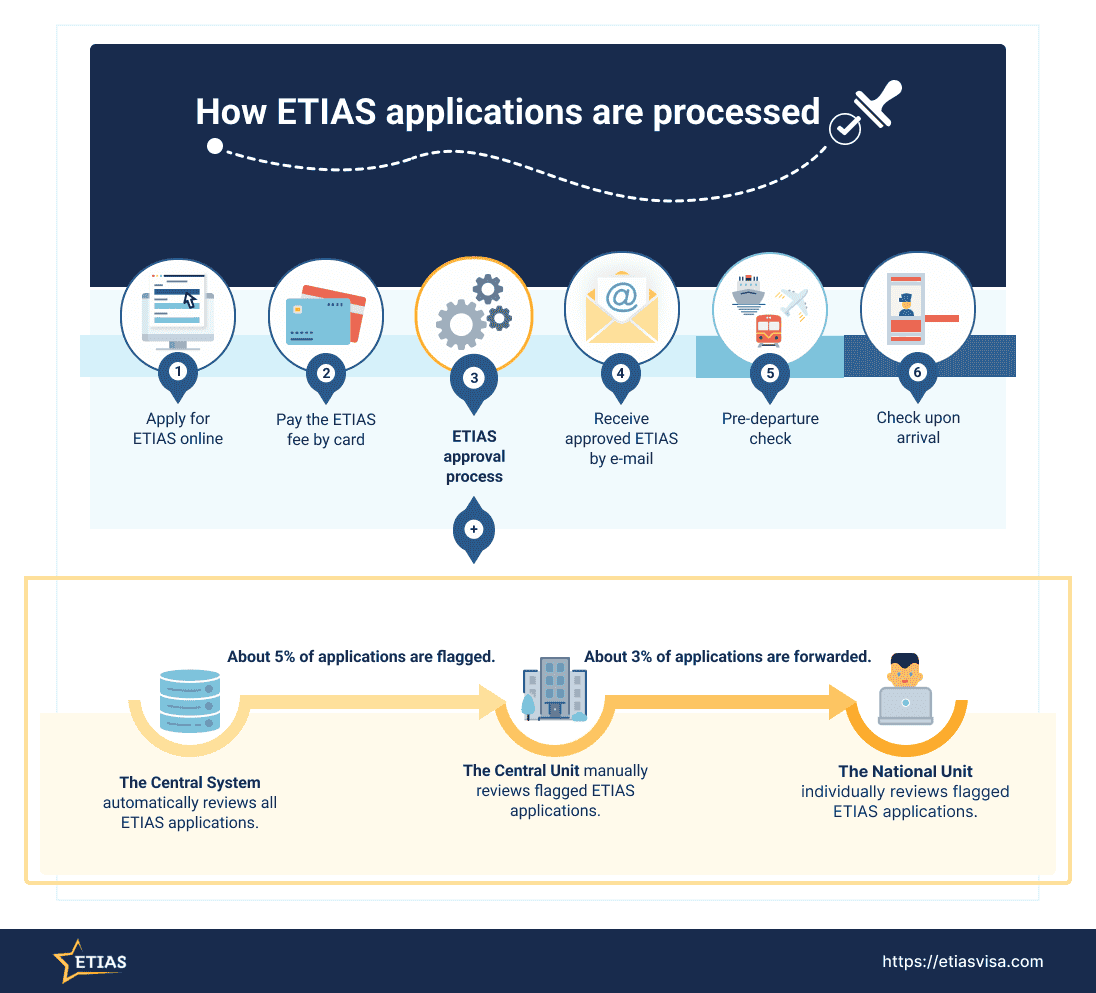
The ETIAS Central Unit (ECU) is the body responsible for running the European Travel Information and Authorisation System (ETIAS).
The ECU will verify ETIAS visa waiver applications and manage the processes involved with the system.
The ECU is there to ensure the Schengen Area’s new travel authorisation system runs smoothly. It provides support to the large-scale information systems implemented by eu-LISA.

WHAT DOES THE ETIAS CENTRAL UNIT DO?
The main roles of the ETIAS Central Unit are to verify visa waiver requests and to provide support and assistance to carriers, passengers, and Member States of the Schengen Area.
The ETIAS Central Unit will be responsible for the following:
- Verifying ETIAS registrations when an applicant’s identity has been flagged by the automated system
- Setting up and maintaining the Carriers Assistance Centre
- Providing support to travellers using the ETIAS platform
- Defining and managing ETIAS screening regulations
- Regularly testing and auditing the systems, procedures, and rules, and how they are implemented
- Protecting and managing personal data collected by ETIAS
- Providing information about ETIAS to the public
There will be 4 divisions of the ECU to handle different tasks:
- Application Handlers Unit
- Assistance Centre Unit
- Data Management Office
- Coordination Office
THE APPLICATION HANDLERS UNIT OF THE ECU
The Application Handlers Unit is the division of the ECU that will process ETIAS applications.
It will be in continual operation, 24 hours a day, 7 days a week, all year round.
This Unit is the one responsible for:
- Receiving and processing the data of third-country travellers
- Issuing ETIAS travel authorisations
THE ASSISTANCE CENTRE UNIT OF THE ECU
The Assistance Centre Unit will be responsible for providing help with the ETIAS and European travel.
It is there to assist:
- Travellers
- Carriers
- Border authorities
It will be in operation 24/7.
THE DATA MANAGEMENT OFFICE OF THE ECU
This division of the ECU will oversee the operation of processing traveller data.
To this end, it will carry out self-monitoring procedures and data controller functions.
THE COORDINATION OFFICE OF THE ECU
The Coordination Office, as its name suggests, will be responsible for coordinating ECU operations. Its functions include:
- Business management
- Corporate planning
- Reporting
WHY DOES THE ETIAS CENTRAL UNIT NEED TO VERIFY MY APPLICATION?
The ETIAS is designed to be quick and easy to use. Once travellers have completed their ETIAS application form, the automated system will cross-check the information against security databases. It is expected that the vast majority will be approved automatically.
It is predicted that in certain cases, the automated ETIAS registration system will flag the applicant as a potential security risk. In this case, the ECU would review the application manually and screen the traveller.
An application may be flagged for one of the following reasons:
- Inconsistent information provided
- The applicant’s identity appears on one of the security databases
- The applicant’s passport has been reported lost or stolen
The following databases will be used for screening ETIAS applicants:
- Schengen Information System (SIS)
- Visa Information System (VIS)
- Europol Data
- Interpol Stolen and Lost Travel Document database (SLTD)
- Interpol Travel Documents Associated with Notices database (TDAWN)
- Entry/Exit Systems (EES)
- New Eurodac Database
- ETIAS watchlist
ETIAS applicant are advised to enter their details carefully and double-check everything is correct before submitting the online form. This can help avoid being flagged for inconsistencies in the information.
WHAT HAPPENS IF THE ETIAS CENTRAL UNIT CHECKS MY APPLICATION?
If an ETIAS applicant is flagged by the system, an ECU operator will review the application and verify why it has been brought to their attention. They will manually screen the information and the applicant’s identity against the security databases.
This is a quick process. The results are then sent to the ETIAS National Unit of the Schengen country the traveller intends to arrive in first.
The National Unit then makes the final decision on whether to authorise entry for the applicant.
It is expected that in most cases, the traveller will be deemed not to be a security risk, and will be allowed to enter.
In the event that they do not meet the ETIAS requirements, or if it is decided that they pose a risk to the security of the Schengen Area, the ETIAS visa waiver may be denied.
If this happens, the National Unit will inform the applicant. They will also provide information about their right to appeal and how to go about this.
The Central Unit provides advice and support to the National Units, working to ensure the security of the Schengen Area for residents and visitors alike, while upholding the rights of travellers.
WHAT IS THE ROLE OF FRONTEX IN THE ETIAS CENTRAL UNIT?
Frontex (the European Border and Coast Guard Agency) is responsible for establishing and managing the ECU.
It has already trained the first batch of Central Unit operators, including application handlers, traveller & carrier support operators, and team leaders.
Frontex is also helping to set up ETIAS National Units in each Schengen Member State and provide training to operators who will work with those in the Central Unit.
The agency is in charge of coordinating the project and all its interconnected parts.
With regards to the ETIAS Central Unit, Frontex plans to hire and train a further 200 members of staff before the online visa waiver system becomes fully operational.
ETIAS CENTRAL UNIT VS NATIONAL UNITS
The ETIAS Central Unit will work closely with ETIAS National Units in screening visa waiver applications and providing assistance to carriers and travellers.
There is only one Central Unit, headquartered in Warsaw.
Each Schengen member country will have its own National Unit.
ETIAS applications that are flagged by the automated system will first be screened by the Central Unit. The ECU operator will then send their findings and recommendations to the relevant National Unit.
The National Unit’s responsibilities include:
- Conducting risk assessments on flagged travellers
- Give a final verdict on whether to grant applicants a visa waiver
- Inform travellers of the appeal procedure
- Maintain the ETIAS watchlist
Travellers and carriers who need help are more likely to deal with the Central Unit by contacting the Assistance Centre.
Conversely, individuals who have an issue with their application will be contacted by one of the National Units and are less likely to have interactions with the Central Unit.

